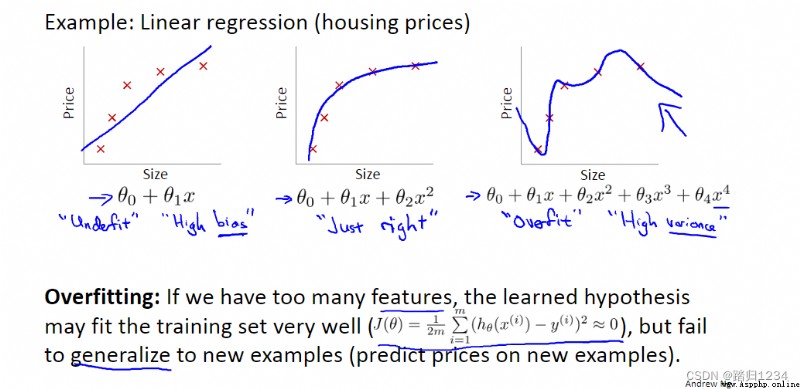
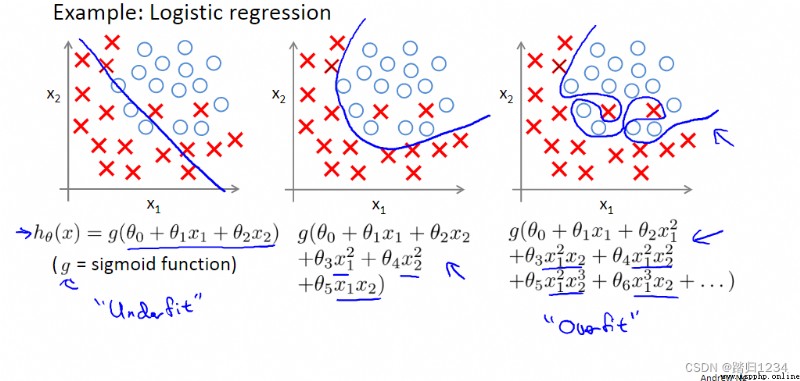
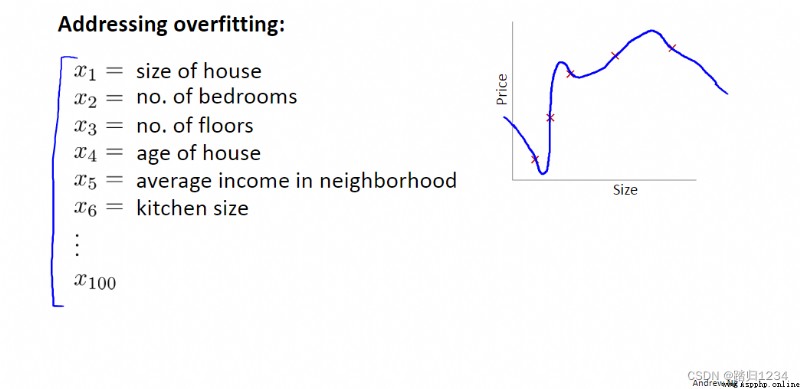
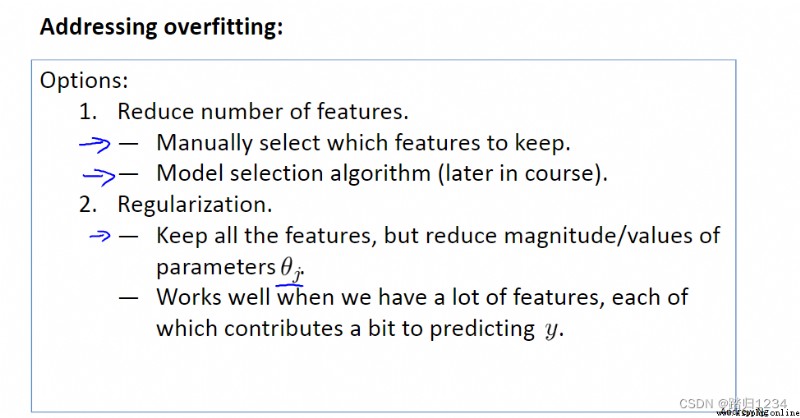
目標:介紹正則化(regularizition)如何應用,並寫出相應的代價函數。
比如,在代價函數中加入 θ 3 、 θ 4 \theta_3 、\theta_4 θ3、θ4的懲罰項,使得它們接近於0,最終的假設模型中 x 3 、 x 4 x^3、x^4 x3、x4的系數很,小,從而假設模型近似於二次函數。
如果參數值較小,那麼參數值較小意味著一個更加簡單的假設模型(hypothesis)。一般來說,這會使得最終得到的函數更加平滑、更加簡單,也不容易出現過擬合問題。
在實際應用中,因為不知道哪個特征變量屬於高階項,所以修改代價函數,直接縮小所有的參數,即 J ( θ ) J(\theta) J(θ)。值得注意的是,代價函數中沒有給 θ 0 \theta_0 θ0增加懲罰項,這是約定俗稱的一種做法,實際上無論是否給它加入懲罰項對結果的影響都不大。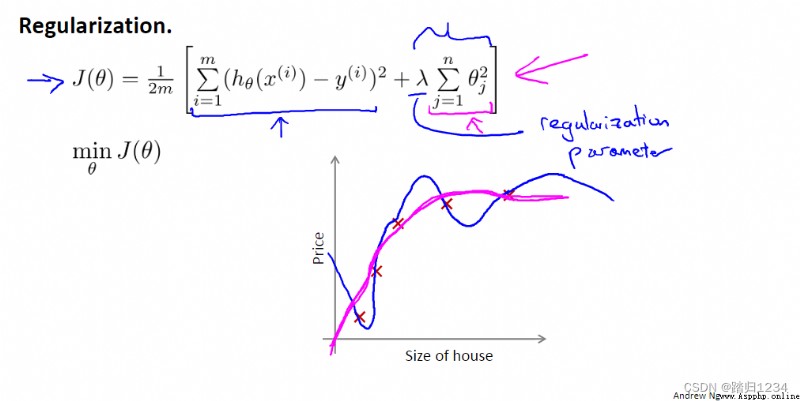
正則化代價函數 J ( θ ) J(\theta) J(θ)(regularized cost function ,正則化的優化目標 regularized optimization objective)中最右邊的求和項即正則化項(regularization term), λ \lambda λ為正則化參數(regularization parameter)。 λ \lambda λ的作用即為控制不同目標間的取捨,目標一:更好得擬合數據集;目標二:保持參數盡可能小。
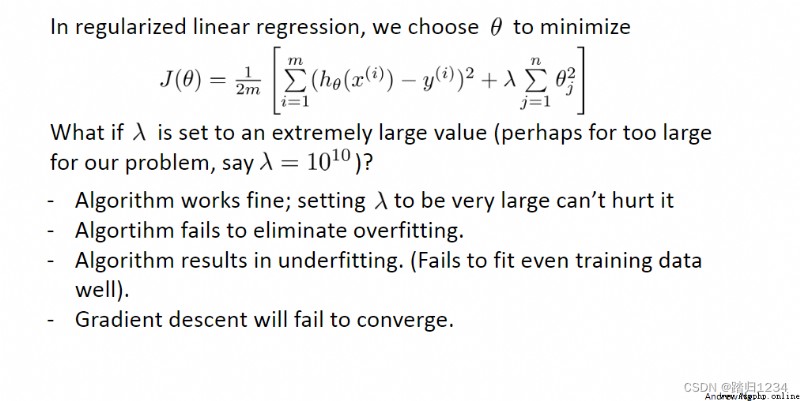
λ \lambda λ越大,各個 θ \theta θ越接近0,相當於把假設模型中的各個特征變量都忽略,從而導致擬合直線幾乎變成一條平行的直線,導致擬合效果不好。因此需要合理選擇正則化參數 λ \lambda λ的值。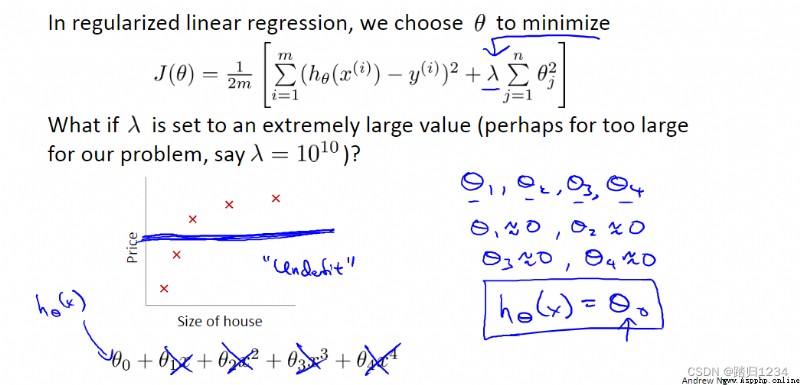
目標:正則化在線性回歸方程中的應用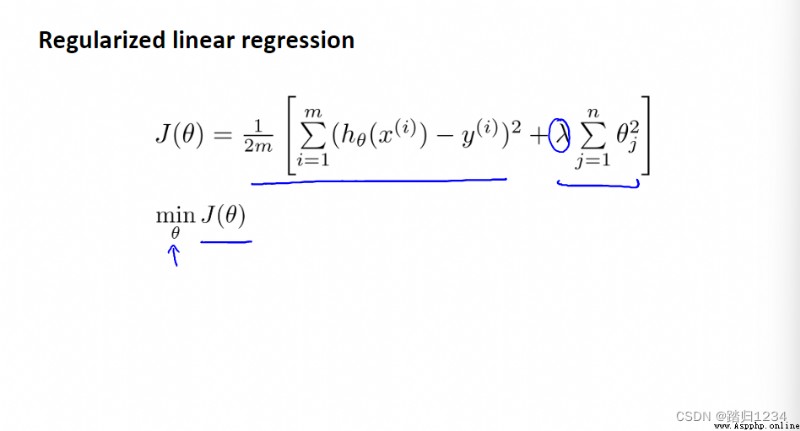
線性回歸梯度下降時,參數 θ \theta θ變化如下。
θ j : = θ j ( 1 − α λ m ) − α 1 m ∑ i = 0 m ( h θ ( x ( i ) ) − y ( i ) ) x j ( i ) \theta_j := \theta_j(1-\alpha\frac \lambda m)-\alpha \frac 1m \sum_{i=0}^m(h_\theta (x^{(i)})-y^{(i)})x_j^{(i)} θj:=θj(1−αmλ)−αm1∑i=0m(hθ(x(i))−y(i))xj(i)
其中, 1 − α λ m 1-\alpha\frac \lambda m 1−αmλ通常是比1略微小的數。
因此,直觀來說,正則化即每次把參數縮小一點點。從數學上來說,所做的還是對代價函數 J θ J\theta Jθ進行梯度下降。
注意, θ 0 \theta_0 θ0不用添加 λ m θ 0 \frac \lambda m \theta_0 mλθ0。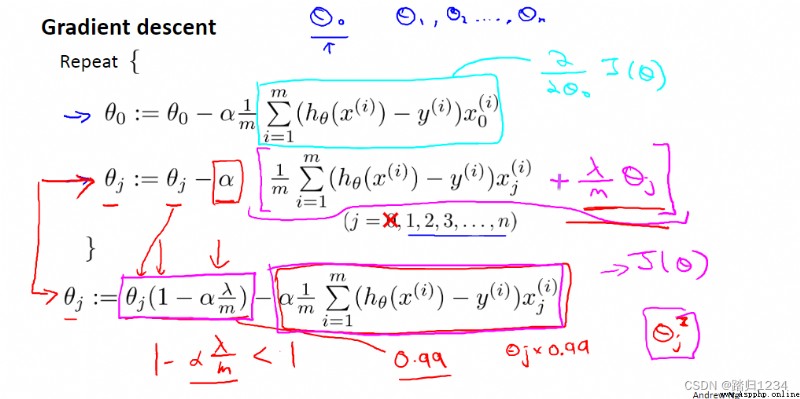
梯度下降只是擬合線性回歸模型的一種方法,下面展示另一種方法——正規方程(normal equation)。
設計一個m*(n+1)維 矩陣X,它的每一行都代表一個單獨的訓練樣本。建立一個m維向量y,包含訓練集裡的所有標簽。
則,全局最小值的參數 θ \theta θ 如下: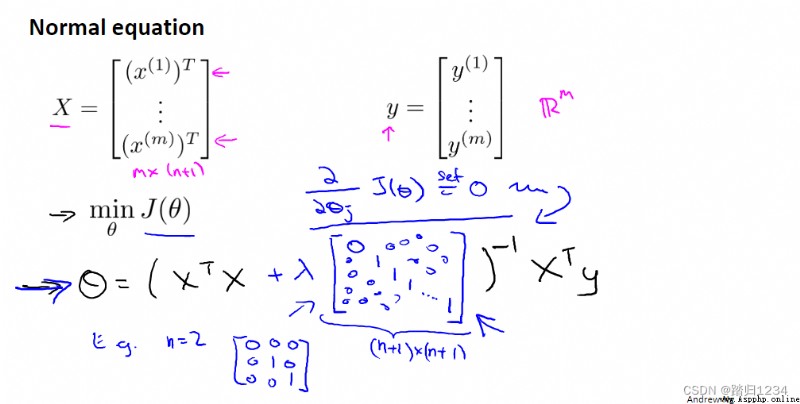
對於一般的線性方程,當m小於等於n時,矩陣 X T X X^TX XTX不可逆,正規方程不可用。
但對於正則化後的方程,可以保證 X T X + λ [ 0 0 ⋯ 0 0 1 ⋯ 0 ⋮ ⋮ ⋱ ⋮ 0 0 ⋯ 1 ] X^TX+\lambda\begin{bmatrix} 0&0&{ \cdots }&0\\ 0&1&{ \cdots }&0\\ { \vdots }&{ \vdots }&{ \ddots }&{ \vdots }\\ 0&0&{ \cdots }&1 \end{bmatrix} XTX+λ⎣⎡00⋮001⋮0⋯⋯⋱⋯00⋮1⎦⎤ 為非奇異矩陣,即一定可逆。
因此正則化還可以解決正規方程中的不可逆問題。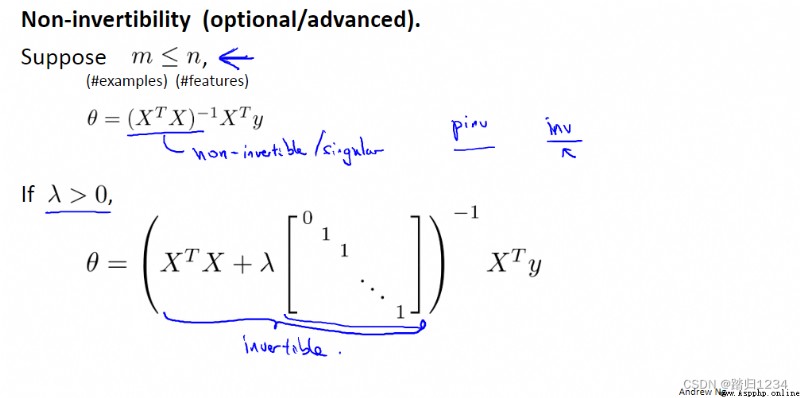
目標:了解正則化如何應用到logistic回歸函數。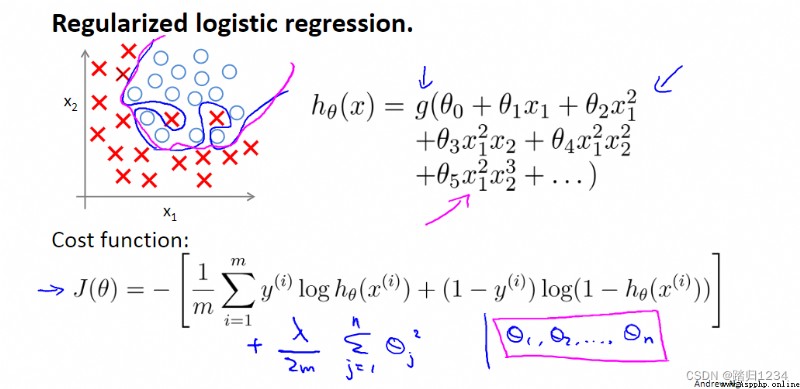
與線性回歸類似,也是在 θ j \theta_j θj中加入 λ m θ j \frac \lambda m \theta_j mλθj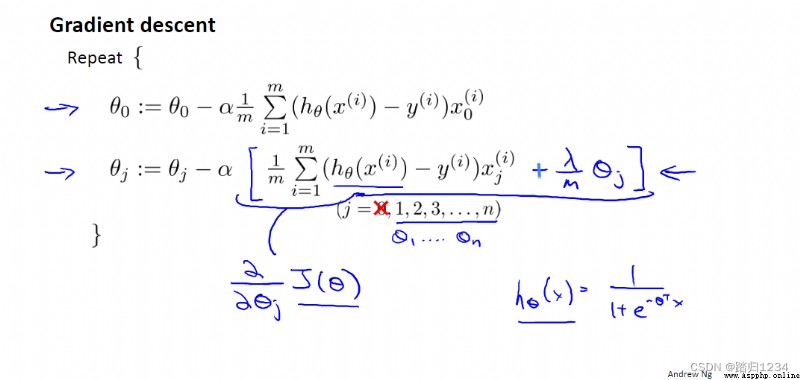
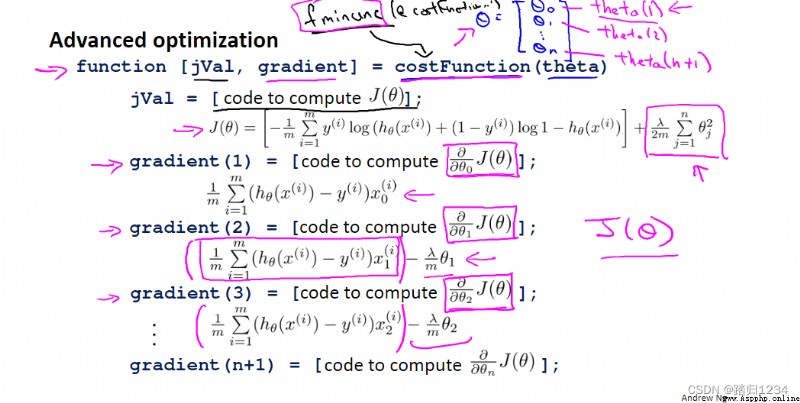
正則化邏輯回歸 python代碼實現
"logistic regression"
import pandas as pd
import numpy as np
import matplotlib.pyplot as plt
import seaborn as sns
from sklearn.model_selection import train_test_split
from sklearn.preprocessing import StandardScaler#標准化
from sklearn.metrics import confusion_matrix,roc_curve,auc,classification_report #分類度量方法
class logisticRegressionGradientDescent:
""" 邏輯回歸,采用批量梯度下降,交叉熵損失函數 """
def __init__(self,dataset,attribute_list,aplha,mylambda):
""" 類初始化 :param dataset:數據集 :param attribute_list:特征列表 :param aplha:學習率 :param mylambda:正則化參數 """
self.alpha=aplha
self.attr_list =attribute_list[:-1]#特征值
self.target_lable=attribute_list[-1]#目標列名(取最後一列)
#數據標准化
self.X= StandardScaler().fit_transform(dataset.iloc[:,:-1])
#對目標值進行編碼
self.y,self.class_lables = self.target_encode(dataset.iloc[:,-1])
#劃分數據集,分層抽樣(stratify 按照列標y) random_state隨機種子,防止每次運行結果重現
self.x_train,self.x_test,self.y_train,self.y_test=\
train_test_split(self.X,self.y,train_size=0.8,random_state=1,stratify=self.y)
self.n,self.k=self.x_train.shape #訓練數據樣本量,特征變量個數
self.cross_entropy_cost = []#每次訓練交叉熵的平均值
self.bdg_weight= dict()#每次訓練權重更新
self.mylambda=mylambda#正則化參數
@staticmethod
def sigmoid(y_preval):
''' 激活函數 :param y_preval: 樣本值乘以權重系數後的值,數組 :return: '''
return 1/(1+np.exp(-y_preval))
@staticmethod
def target_encode(target):
""" 靜態方法,不用self,標記 @staticmethod 二分類類別編碼為0,1 :param self: :param target: 類別列表 :return: """
class_lables=target.unique()# 獲取不同類別值
if len(class_lables)>2:
print("此邏輯回歸只是限於二分類,請選擇多分類算法")
exit(0)
if(class_lables.max()==1 and class_lables.min()==0):
return target.tolist(),class_lables
else:
#編碼,采用列表推導式
target_y = [0 if y == class_lables[0] else 1 for y in target]
return target_y,class_lables
def logistic_regression_model_train(self,max_lop,threshold):
''' 邏輯回歸訓練函數,采用批量梯度下降法,交叉熵損失函數 :param max_lop: 最大訓練次數 :param threshold:退出訓練阈值 :return: '''
np.random.seed(101)#設置隨機種子,避免每次都一樣
weight =np.random.random(self.k)/100 #隨機化權重 權重數同特征變量數 random模塊的random函數
weight_old =weight
for j in range(self.k):
self.bdg_weight[str(j)]=[]
for loop in range(max_lop):
self.alpha*=0.95#衰減指數慢慢減少
y_hat = self.sigmoid(self.x_train.dot(weight.T))#激活函數·,預測屬於某一類別的概率(0,1) 求x乘以權重 矩陣計算
dw= ((y_hat-self.y_train)*self.x_train.T).mean(axis=1)#權值更新 對所有的列求均值 結果等同於(self.x_train.T*(y_hat-self.y_train)).mean(axis=1)
weight=(1-self.alpha*mylambda/len(y_hat))*weight-self.alpha*dw #權值更新
#weight=weight-self.alpha*dw #權值更新 未正則化
for j in range(self.k):
self.bdg_weight[str(j)].append(weight[j])
#交叉熵損失均值 1e-10是因為防止log後取值太小對結果產生影響
ce_loss =-(np.array(self.y_train)*np.log(y_hat+1e-10)+
(1-np.array(self.y_train))*np.log(1-y_hat+1e-10)).mean()+1/2*mylambda*np.power(weight, 2).sum()/len(y_hat)
# ce_loss =-(np.array(self.y_train)*np.log(y_hat+1e-10)+
# (1-np.array(self.y_train))*np.log(1-y_hat+1e-10)).mean()#未正則化
self.cross_entropy_cost.append(ce_loss)
#退出條件,避免過擬合,提前停止訓練
if(len(self.cross_entropy_cost)>2):
if np.abs(self.cross_entropy_cost[-1]-self.cross_entropy_cost[-2])>threshold:
break
elif np.abs(weight-weight_old).all()<threshold:
break
else:
weight_old=weight
# #畫圖
# plt.plot(self.cross_entropy_cost)
# plt.show()
return weight
def plt_cost(self):
""" 繪制交叉熵損失下降曲線 :return: """
plt.plot(self.cross_entropy_cost)
plt.xlabel("Training times")
plt.ylabel("Cross entropy cost")
plt.title("Decline curve of loss function in Logistic regression")
# plt.show()
def plt_weight(self):
""" 繪制權重更新曲線 :return: """
for k in range(self.k):
plt.plot(self.bdg_weight[str(k)],label=self.attr_list[k])
plt.legend()
plt.xlabel("Training times")
plt.ylabel("Weight")
plt.title("Logistic regression weight coefficient update curve")
def predict(self,weight):
""" 測試樣本預測類別,並根據概率進行類別編碼 :param weight:訓練最終權重 :return: """
y_pred =[]#預測類別
y_score =self.sigmoid(self.x_test.dot(weight.T))
threshold =0.5 # 類別不平衡問題需要考慮阈值,待解決
for y in y_score:
if y<threshold:
y_pred.append(0)
elif y>= threshold:
y_pred.append(1)
cm= confusion_matrix(self.y_test,y_pred)
acc= np.sum(np.diag(cm))/len(y_pred) #預測精度
return y_pred,cm,acc,y_score
def plt_confusion_matrix(self,cm,acc):
""" 繪制混淆矩陣 :param cm: 混淆矩陣 :param acc: 預測精度 :return: """
cm =pd.DataFrame(cm,columns=self.class_lables,index=self.class_lables)
sns.heatmap(cm,annot=True,cbar=False,fmt='d')#繪制熱圖
plt.xlabel("Predict")
plt.ylabel("True")
plt.title("Confusion matrix and accuracy =%.2f%%" %(acc*100))#%%表示直接輸出一個%
def plt_roc_auc(self,y_score):
""" 繪制ROC曲線,並計算AUC :param y_score: 預測樣本預測評分 :return: """
false_positive_rate,true_positive_rate,_ =roc_curve(self.y_test,y_score)
roc_auc=auc(false_positive_rate,true_positive_rate)
plt.plot(false_positive_rate,true_positive_rate,"b",label="AUC=%.2f" % roc_auc)
plt.legend(loc="lower right")
plt.plot([0,1],[0,1],"r--")
plt.xlabel("False_positive_rate")
plt.ylabel("True_positive_rate")
plt.title("Logistic Regression of Binary Classification ROC Curve and AUC")
if __name__=='__main__':
url="../datasets/Mtrain_set.csv"#數據集路徑
data=pd.read_csv(url).dropna().iloc[:,1:]
attribute_list =data.columns#列名列表 list列表,沒有loc屬性
alpha =0.8
mylambda=1000
#print(attribute_list)
lrgd=logisticRegressionGradientDescent(data,attribute_list,alpha,mylambda)#正則化處理
# lrgd=logisticRegressionGradientDescent(data,attribute_list,alpha)#沒有正則化
weight=lrgd.logistic_regression_model_train(1000,1e-8)
print("正則化邏輯回歸,采用批量梯度下降法訓練,最終特征變量系數:")
for i in range(lrgd.k):
print(" %-10s %.15f" % (lrgd.attr_list[i],weight[i]))
y_pred,cm,acc,y_score =lrgd.predict(weight)
#繪圖
plt.figure(figsize=(12,10))
plt.subplot(221)#表示將整個圖像窗口分為2行2列, 當前位置為1.
lrgd.plt_cost()
plt.subplot(222)
lrgd.plt_weight()
plt.subplot(223)
lrgd.plt_confusion_matrix(cm,acc)
plt.subplot(224)
lrgd.plt_roc_auc(y_score)
plt.show()
#還可以再打印出一個分類報告
運行結果
數據擬合效果欠佳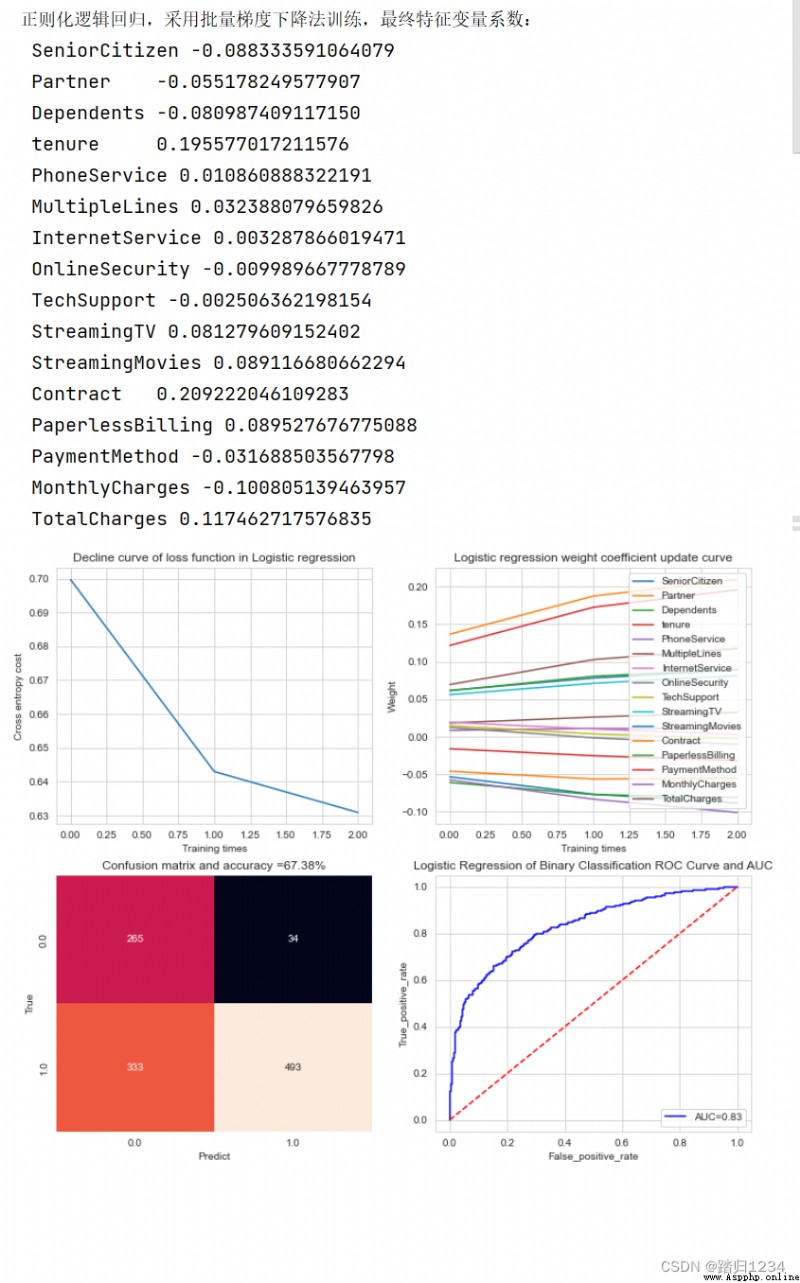
參考資料
網易版 吳恩達機器學習
2021機器學習(西瓜書+李航統計學習方法)實踐部分 + Python
 Python+opencv to realize image edge detection (sliding adjustment threshold)
Python+opencv to realize image edge detection (sliding adjustment threshold)
Python+OpenCv Realize image ed
 Python implements Bayesian ridge regression model (bayesianridge algorithm) and uses k-fold cross validation for model evaluation project practice
Python implements Bayesian ridge regression model (bayesianridge algorithm) and uses k-fold cross validation for model evaluation project practice
explain : This is a practical